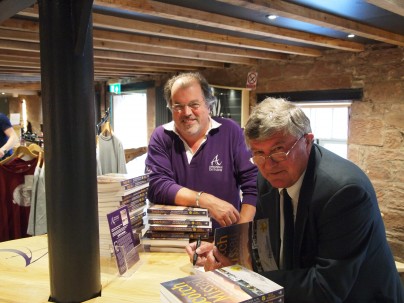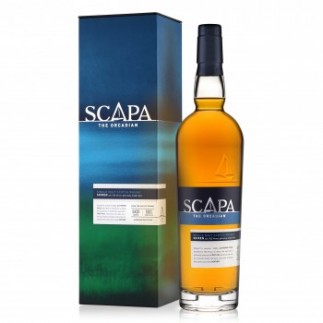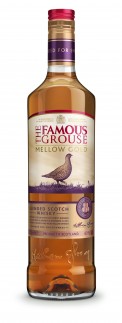29.07.15
Parties, Books and New Whisky
Okay, that should be party and book, singular. Two whiskies, though.
At the beginning of this month I was back on Islay, hugely privileged to have been a guest at the Bruichladdich Distillery retirement party for Master Distiller, James McEwan. It was one helluva party. Didn’t even dance that much at a wedding I attended last August. James actually retired last week on Thursday 23rd July, his birthday, after 52 years in the Scotch Whisky industry. Not many people get to stay that long any more. Of course many believe he’ll be back to do some more talks and tastings – he could easily tour a one-man stand-up whisky comedy show worldwide – or help new distilleries but we’ll have to wait and see. Meantime there are grandchildren to be played with and some chilling out to do.

I promised last month that I’d post a review of “Scotch Missed” by Brian Townsend once I’d received a copy and it came in recently. In a glossy soft cover, it splits Scotland’s lost distilleries into regions. There are so many it seems tragic, especially in Campbeltown where there used to be over twenty but I guess the laws of economics and natural selection (quality, taste issues, drinking trends, over-supply, world wars and business management) do what they do.
Some I had heard of, particularly on Islay and in Highland/Speyside but others, never at all. They’re obviously not covered by the subject matter of this book but we do also know that new distilleries are now being built – or planned – where there used to be old ones and that some have been completed in new places too. I found the book a fascinating read – not dry at all – combining social and industrial history with that of Scotch Whisky and you can either read it in sequence or dip into it by distillery or by region as the mood takes you, dram in hand of course. Just looking at the photographs and illustrations can pass a happy time.
The regions as used here are the North, Speyside and the North East, the East Coast and Tayside , Central and Lothian, Fife, Edinburgh, the South and Borders, Glasgow, Strathclyde and the West of Scotland, the West Highlands, Islands and Islay and, lastly, Campbeltown. Eleven seems a lot, rather than the traditional four or five, depending on how you judge Speyside and Highland. A good buy for anyone interested in the history of Scotch Whisky as it covers the beginnings and development of the industry in a most readable form as well as charting the various rises and falls Scotch Whisky has seen. It’s available from the publisher or on Amazon. I’m a big believer in buying direct from the publishers where possible. It’s £19.99 from The Angels’ Share (an imprint of Neil Wilson Publishing).


There have also been a few new whisky expressions out recently and two I was sent samples to try are The Famous Grouse Mellow Gold and Scapa Skiren. Let’s start with the blend first. We all know The Famous Grouse but how many have tried Black Grouse or Snow Grouse – or even the Naked version? Well, time to move on to a new colour in the form of Mellow Gold (40% abv). It is indeed a mellow, old gold to look at. On the nose and palate it’s a bit deeper and richer than TFG but still has the fruity (a touch of ripe banana?), honeyed and slightly smoky notes we’ve come to expect.
I rather liked this one on its own, never mind using with mixers or in cocktails. I’m sure it would be good for those too, adding a little more depth of flavour, but it stands up on its own two feet. I left it out in the glass for a while to open out as this cold summer isn’t doing anything for the room temperature in my house and I’m determined not to crack and switch the heating back on. It took a couple of hours but it did emerge with slightly more toffee notes on the nose as well as some waxiness after adding water. They have used more sherry cask whisky in this blend than for the standard bearer TFG and that is detectable. There is new packaging which will extend across the Grouse range and this addition creates a nice group with which to try a purely Grouse tasting.
Scapa Skiren is from Scapa on Orkney and this one really intrigued me. Not the fact that there’s no age statement or that it’s 40% abv but it has a really unusual nose. Perfumed – almost cologne-like, floral, sweetly spicy with pear juice and some tropical juice notes and not so much like the age-statemented Scapas I’m used to. Some cooked citrus notes too, not to mention the warm, old wood floorboards and herbal tinges. Skiren is apparently Old Norse, meaning “glittering, bright skies” – odd how this and Gaelic seem able to convey a lot of meaning in one simple word! This is produced in a Lomond still – the only working one still in the Scotch industry. I thought there was one other Lomond still in use but that’s what the info told me. Must check that out just to scratch the itch I have about it. Meantime, I’d encourage you to get hold of this one and try it. Fascinating.
Some other new info recently in but we’ll save that for August.
Cheers for now,
Caroline
Comments